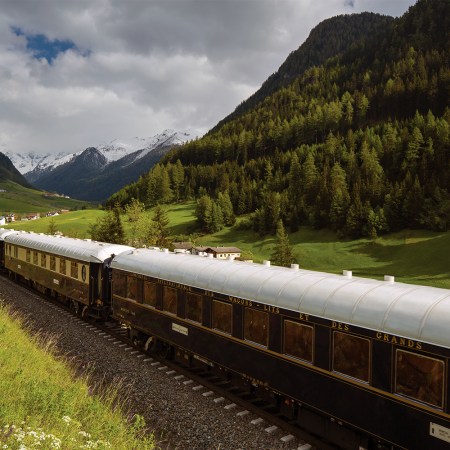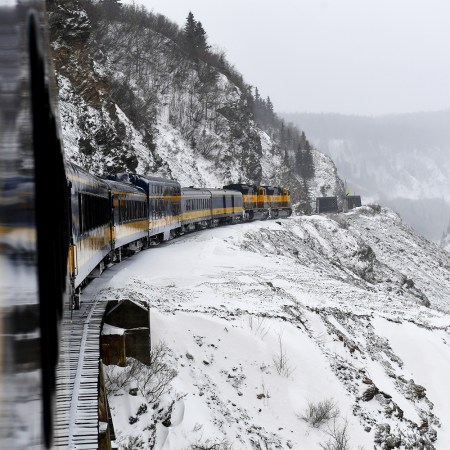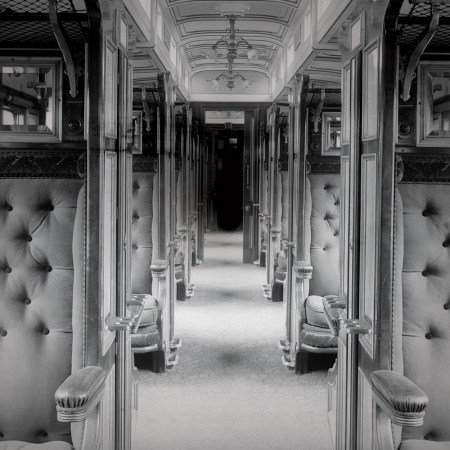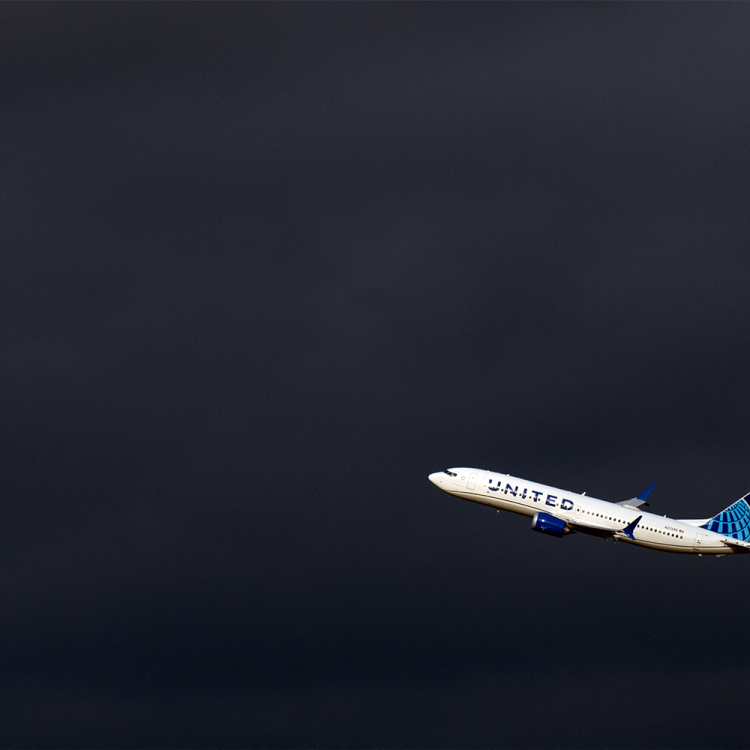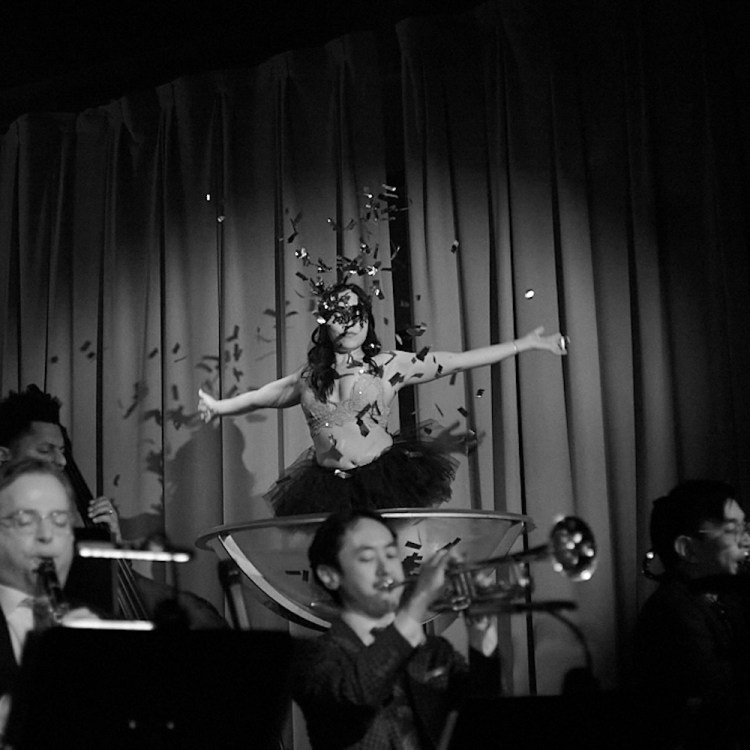
Todd Parsons is working on a problem. It’s a math problem. Calculus. He is a professor at the Sorbonne in Paris, where he applies probability theory to biology as a way to predict how and why diseases spread. He hopes it’ll help governments plan for better public health.
We are in the Observation Car of Amtrak’s Starlight, riding from Los Angeles to Berkeley. Parsons will continue on to Seattle. The Starlight hums along at a clip of around 75 miles an hour just outside of Paso Robles, where the hills are turning purple in the gloaming.
The Observation Car is packed with passengers. Some sit at booths and play cards, work on laptops or just take in the countryside. Others, like Parsons, sit in the bucket seats that face the windows.
“I pretty much park my butt here and work all day,” Parson says, his aged leather boots perched on the ledge, just above the power outlets that charge his MacBook. He is touring the States on a lecture circuit, having purchased Amtrak’s $689 rail pass, which allows him up to 12 “segment” rides over the course of a month (a segment refers to any single, point-to-point ride a passenger takes, regardless of length). “I think there are a fair amount of academics taking the rails these days,” he says before swigging water from a steel water bottle.
He’s right. The passenger assigned next to me in coach, Barbara Peterson, is the Executive Director of UC Berkeley’s Neuroscience Department. She’s visiting her son in Carpinteria, and picked up the Starlight in Oxnard because she didn’t want to be in her car all day. Here, she gets work done.
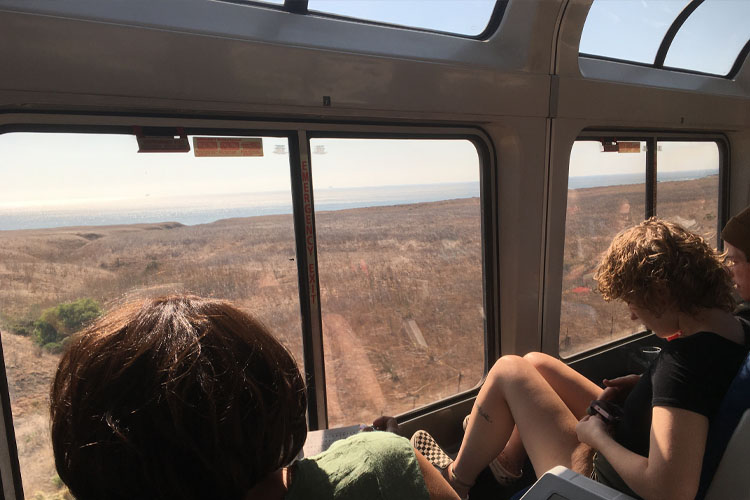
Being able to work is nice, but there’s a more fundamental reason that Parsons and Peterson travel by rail: it reduces their carbon footprint. Parsons cites Kevin Anderson’s essay Hypocrites in the Air, an indictment of academics who champion environmental causes while flying around the globe on lecture circuits, spray-painting the air with noxious chemicals as they go. You might also remember the indignation that erupted earlier this year around Google Camp, a $20 million event largely focusing on climate change that attracted everyone from Leonardo DiCaprio, Katy Perry, Prince Harry and Barack Obama … as well as the 114 private jets and handful of megayachts they rode in on.
Until a few months ago, this concept — “flight-shaming,” which owes its etymology to a Swedish word, flygskam — was mostly a thought exercise for climate activists and progressive media. But it’s now developed into a genuine cultural movement thanks to its very own patient zero: Greta Thunberg, the 16-year-old Swede who literally and figuratively set sail this past summer to castigate legislators around the Western world for leaving her generation with an Earth-shaped mess to clean up.
The more realistic alternative to air travel for Americans is, of course, the country’s rail system. Parsons travels almost exclusively by train in Europe because the trains there are plentiful, efficient and reliable. He figured he could do the same in the States, which is why he bought the Amtrak pass. But Parsons’s case is a unique one: his job and travel schedule allow him to take his time between destinations. Most business travelers can’t justify a train from Houston to L.A. (more than 35 hours long), or even the one from L.A. to Berkeley (about 10 hours).
We know that trains represent the most efficient and environmentally sound way to transport large groups of people over land. But for Americans, logistics remain an issue: Is it possible for us as a society to travel this way? And if so, what needs to happen for more people to embrace it?
To answer those questions, we first need to go back in time.
In the Beginning, There Were Trains
It is not an exaggeration to say that trains made our nation the economic powerhouse it is today. The total landmass of the United States exceeds 3.7 million square miles (or 3.1 million, if you remove the sprawling and disembodied tundra that is Alaska), and uniting it with a reliable mode of transportation has been pivotal in trade and industrial growth, from producing energy to shipping goods to moving people around for work and leisure.
It’s how Montgomery Ward and Sears-Roebuck built their catalogue-business empires. It’s how the frontiersmen and prospectors who settled the West chased their claims to the shores of the Pacific. The advent of freezer cars ferried produce and beef to a growing nation, and when passengers needed a reliable schedule, Congress adopted the time zones we still use today. Tourism — from the deepest bayous of Florida and Louisiana all the way to the sunkissed hillocks of coastal California — flourished.
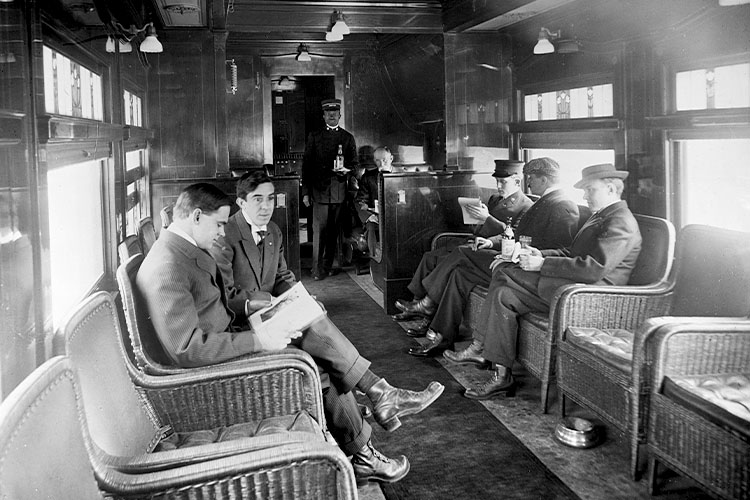
Trains are a fascinating lens through which to view our history, as the development of the railroad runs through nearly every major socioeconomic development since tracks were first laid in the early 1830s. This is recounted in detail by British journalist and historian Christian Wolmar in The Great Railroad Revolution. “I found writing in America fascinating,” Wolmar tells me from his home in the UK. “The tension between public and private is still playing out. Even today — Amtrak is now public.”
The tension that Wolmar is referring to is a long and storied one. With the exception of a brief period during World War I, passenger service on U.S. rails was private until the latter half of the 20th century. Though ridership flagged during the Depression, it grew steadily in the ‘40s and recovered entirely during World War II (think of the iconic photos of GIs waving goodbye to lovers from their windows).
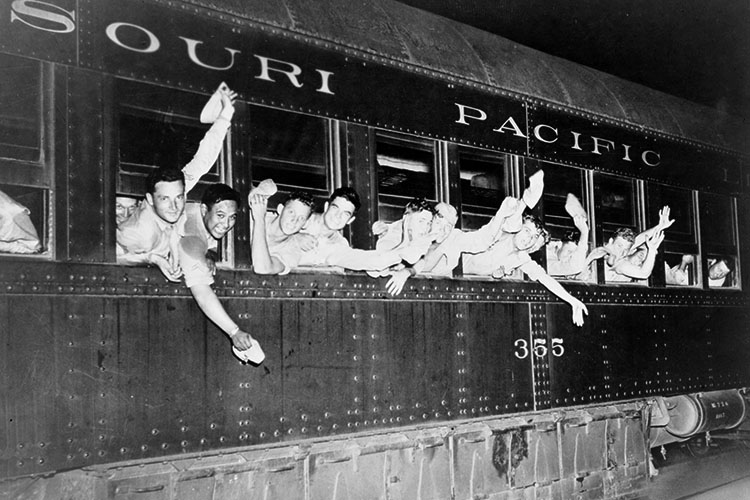
Then came the 1950s, and with them the proliferation of the automobile and airline industries. Dwight D. Eisenhower’s Federal Highway Act of 1956 funded the development of the national interstate system, and airlines began using Boeing 707s, which carried up to 181 passengers. So what if trains could carry double that? The Boeing went 604 mph.
Amid plummeting ticket sales, the private rail companies fell off completely in 1964. The federal government (which had already been subsidizing passenger service for years) officially absorbed control of the country’s railways in 1970, incorporating them under the National Railroad Passenger Corporation — or Amtrak, familiarly.
As Wolmar notes, this endeavor was troubled from the start. The rails were turned loose with a $40 million subsidy and a $100 million loan to fund their operation — paltry sums when compared to the funding that’s being poured into Eisenhower’s interstates to this day. In fact, if you were to total all of Amtrak’s subsidies from its inception to now, it would amount to less than one year’s worth of federal highway funding (more than $41 billion in 2018). By contrast, the federal government invested $1.46 billion into Amtrak last year — the largest sum in its 48 years of ownership.
That lack of resources has made it very challenging for Amtrak to invest in the kind of infrastructure that would actually make it a viable competitor to other modes of transit. Nevertheless, rail usage is experiencing an upswing. Ridership exceeds 17 million trips annually in the Northeast Corridor, where Amtrak is currently in the process of upgrading its flagship Acela trains to be 10 percent more fuel efficient. According to Mark Magliari, Amtrak’s PR Manager, “we carry more people in the Washington-New York-Boston corridor than all the airlines combined.”
In Southern California, the Pacific Surfliner’s ridership increased to 3 million travelers in 2018, enough to warrant them adding a 13th round-trip train each day. The Surfliner can get a Hollywood executive to Comic-Con in San Diego (125 miles) in three hours, about the same amount of time it takes to drive in light traffic, the benefit being that, on the train, they can continue reading scripts and needling their assistants. But as Wolmar says, “I can get from London to Yorkshire — 200 miles — in two hours.”
The Need for Speed
Academics aren’t the only ones on the Starlight. Retirees, pennywise mothers with children, Vets, tourists and folks scared of (or fed up with) flying are also onboard. None of these people, when asked, are in a rush. It’s easy to see why: on the other side of the window, a remote stretch of California’s magnificent coastline rolls past, while inside, everyone is getting work done or connecting with one another. It beats being stuck in traffic or herded through an airport.
After checking into my hotel in San Francisco, I go downstairs to the bar, where I encounter three young employees from Bain Capital. When I tell them I just got off an Amtrak, they’re amused. One says he used to take it up to the Bay Area from USC, but he can’t now, because it takes too long. Time is money, he says.
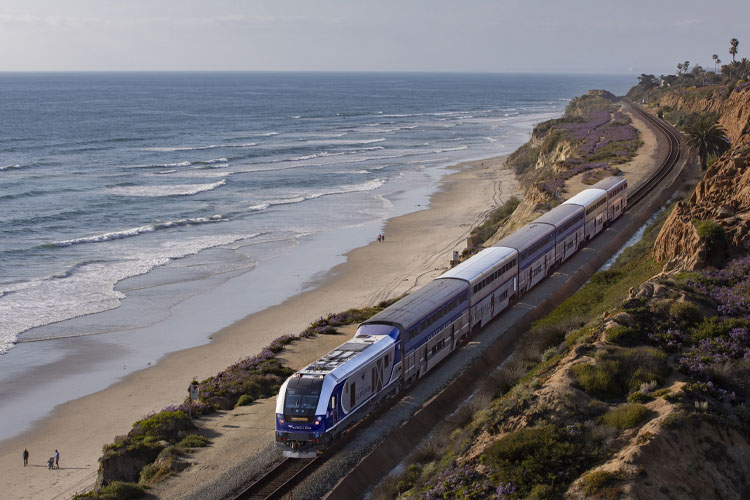
It’s worth noting that our hotel is a Yotel, the Starwood-owned line that specializes in tech-forward, efficiency-driven properties for business travelers. Check-in is executed at agent-less kiosks, and the rooms (called “cabins”) are appointed with the modish white furniture and the soft purple lighting of a Virgin flight. The beds also incline, hospital-style, so guests can sit upright — the idea being that at some point, they’ll probably want to work from bed. It’s indicative of a greater trend in the applied arts, in which spaces and systems are increasingly designed to accommodate a fast-paced, workaholic lifestyle.
For Amtrak, figuring out how to abide that trend is a near-existential question. The solution starts with investment in high-speed trains, and new rails upon which they can operate. At present, passengers trains in America tend to run subsequent to freight, which is still a private business and has priority over the rails. “We don’t own the tracks,” says Magliari. “We have to negotiate with the people who own the tracks about how many trains a day we can run and how and what their schedules will be.” At one point on my trip, near San Luis Obispo, the train stopped for 15 minutes to let a freight train pass.
The obvious solution is to build dedicated passenger lines that can zip around unimpeded. But that requires a famously precious resource: land. America’s extant railways were erected in the days of handshake land grants and eminent domain. Today, laying down thousands of miles of contiguous track is a trickier proposition.
After checking out of Yotel, I rent a car and drive to Sacramento, where Caltrans and the California High Speed Rail Authority (CHSR) are holding a board meeting at the Department of Health and Human Services. When I arrive, California’s locomotive cognoscenti are gathered in what looks like a big courtroom for their board meeting. I’m there to chat with Diana Gomez, the Central Valley Regional Director for CHSR.
“Sometimes I do take Amtrak,” she says of her commute from Fresno. “Depends on what time our meetings start. Since I was going to be here for two days, I drove.” When she takes the train, Gomez contemplates what she can do to make the experience better. “When we’re on high-speed rail, it will be our own right of way, our own tracks,” she says. “We’re going to be grade-separated from cars, which will allow us to travel at 220 miles an hour.”
High Speed Rail development in California is divided into three corridors: Northern, Central and Southern. The Central Corridor, which runs between Bakersfield and Merced, is the first one underway, having broken ground in Fresno on January 6, 2015. They chose to start there because it’s a straight shot, which means they’ll be able to test out a working model sooner. Once they have proof of concept, luring in investors will be an easier task.
Hence today’s meeting. They’re discussing “3P,” or public-private partnerships, like the one that funded BART in San Francisco. “They did that on the Presidio Parkway, where they brought in an operator who funded the construction piece of it, and then Caltrans paid them over a portion of time,” Gomez tells me. “All the money used up front for construction was private funding. That was the first of its kind in California by Caltrans.”
The first big challenge for the Central Corridor’s high-speed project was compiling the land, around 1,500 parcels, much of which was owned or used by utilities. That meant existing infrastructure had to be altered or moved. “With PG&E [Pacific Gas and Electric], we have over 100-plus conflicts,” says Gomez. “That’s where their utilities conflict with our new tracks, so we need to relocate them. It’s a lengthy process to design.”
Before Caltrans relocates a utility, they need to secure a relocation site. Then they design it and ensure that the utility’s prior rights will be re-established. “It is a lot of coordination, a lot of moving parts,” says Gomez. “We are working through all of those issues.”
Relocation, of course, has its benefits. Building new infrastructure means everything has to be updated to current code: fiber optics, sunken utilities — the works. That fiber also runs along the high-speed rail, where passengers will have access to better internet than ever before.
Sustainability-wise, California’s High Speed Rail is also a marvel: 100 percent electric and powered entirely by renewable energy, so it’ll have zero emissions. CHSR will also recycle 97 percent of the waste created by its construction, restore and protect 2,680 acres of open space, and is currently contracted with 129 small local businesses.
A New Hope
If there’s a rub with CHSR’s plan to rebuild California transit from the ground up, it’s the timeline: the completion of the Los Angeles-to-San Francisco route is slated for 2033. But the impact would be tremendous.
The Rail will serve 25 stops in total, and passengers traveling between L.A. and S.F. will be able travel direct: 363 miles at 220 mph with no stops, good for a travel time just under two hours. It currently takes an hour-and-a-half to fly, not including the hour-plus you need to make it through TSA, plus whatever travel time you incur getting to and from the airport. Not to mention the differences in cost — both monetary and environmental.
“It’s very expensive for airlines to fly these short hauls back and forth, back and forth,” says Gomez. Flights between L.A. and S.F. run every 30 minutes, and represent a loss leader for airports, which earn more charging for freight and long-distance flights. “A six-hour flight versus an hour: the hour-longs are very expensive for them.”
It’s for that reason that San Francisco International calls CHSR its third runway. “You know how hard it would be to expand SFO or LAX or any of the airports?” posits CHSR Information Officer Annie Parker. “Airports make their money from freight flights, and if you have more space, you have more room for freight.”
Amtrak’s new CEO, Richard Anderson, came from Delta Airlines, and he also understands the importance of these short-haul trips. Amtrak is currently using the bulk of its funding to upgrade the Acela service in the Northeast Corridor to a high-speed electric, as well as improving the terminals in DC and New York, where the bulk of the business is — and always has been — located.
If Amtrak can’t jump-start CHSR’s development, who will? A number of contenders have emerged, starting with Brightline, a Miami-based company that announced last September that they’d be taking over the XpressWest route from Las Vegas to Los Angeles. The project is fully approved, and Brightline will work with CHSR to provide seamless service.
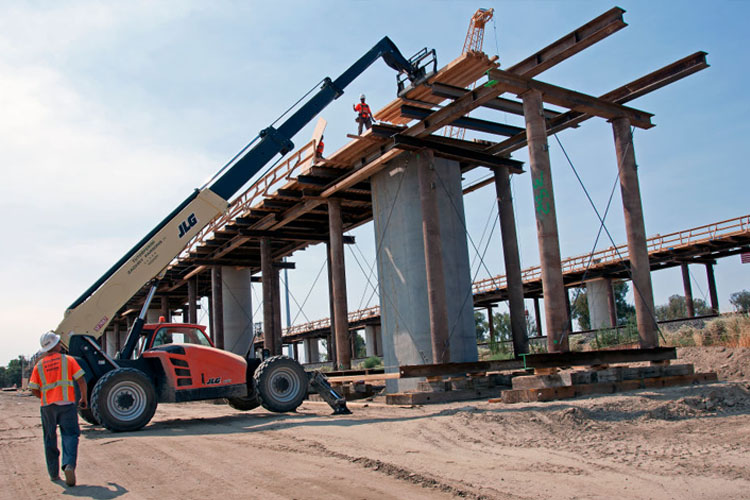
Curious to learn more about the company’s credentials, I book a flight to Miami to meet with Brightline’s brass and check out their current offering: a high-speed train that runs between Miami, Ft. Lauderdale and West Palm Beach.
I’m given a budget of $400 to get to Miami from L.A., which means I can’t fly direct. I book a connection in NYC, which is 1,279 miles out of the way. According to MyClimate’s emissions calculator, I incur .35 tons of extra carbon-dioxide waste in doing so. I also add six hours to my journey, which, as the Bain consultant pointed out, is also a cost.
Where the Starlight’s coach seat had three feet of leg room, my Delta Airbus has about 18 inches. Anxious passengers shuffle down the narrow aisle as a flight attendant helps a flustered passenger shove her roller bag into the overhead bin. I use a hand wipe to clean the tray, armrests and air vent, rendering it the same shade of yellowish brown you’d expect of an Oxy pad after high-school gym class. On the Amtrak Starlight, conductors were buoyant and jovial, joking with passengers and pulling faces at children as they made their rounds. Here, flight attendants have little space or time to deal with stressed-out passengers. They’re also paid around $50,000 on average, while conductors for Amtrak make an average of $64,000. As I listen to a Delta personnel ask customers via the intercom to be more respectful, I reflect on the state of air travel in America, and how what started out as a glamorous and groundbreaking (literally) means of transport has become universally accepted — by both passenger and carrier — as an indignity.
America’s Oldest Private Train Runs Again
Once on the ground in Miami, I take a Lyft to Ft. Lauderdale, where I’ll catch the Brightline the following day. It’s about 90 degrees out, and the air itself seems to sweat. My driver, who looks dressed for the beach, chats with me about the Brightline, saying he wants to take it to Orlando once it’s up and running.
Lyft is a natural bedfellow for a train like Brightline, since “last-mile” travel — that is, the final leg of a journey that was started on a train, plane or bus — accounts for a huge share of its earnings. This is a growing trend in America: people are increasingly opting for public and private travel options that get them out of their cars. In the 1970s, close to 80 percent of 16- to 17-year-old Americans were licensed drivers; today, only 45 percent are. The average Miami driver wastes 105 hours annually in traffic jams; drivers in Los Angeles waste 128 hours each year. The top three worst traffic cities are all in the Northeast, where both public transit and intercity trains have their highest rates of adoption.
Miami and L.A. suffer from similar geographical restraints that prohibit them from building larger freeways. And as is the case in L.A., many of the folks who work in downtown Miami commute from more than 30 miles away. Hence the allure of Brightline, an intercity rail that currently connects Miami, West Palm Beach and Ft. Lauderdale. Though it launched in 2017, it’s actually been around since 1896, and remains America’s oldest private passenger railway.
“There are real psychological benefits to commuting by train,” says Ben Porritt, SVP of Corporate Affairs at Brightline. As if to demonstrate his point, he’s just arrived via Bird scooter, which he took from the Brightline station. He tells me he doesn’t own a car. I try to steer our conversation toward the environmental benefits of riding Brightline (they use a biodiesel derived from cooking oil), but Porritt prefers to talk about the quality of service and experience.
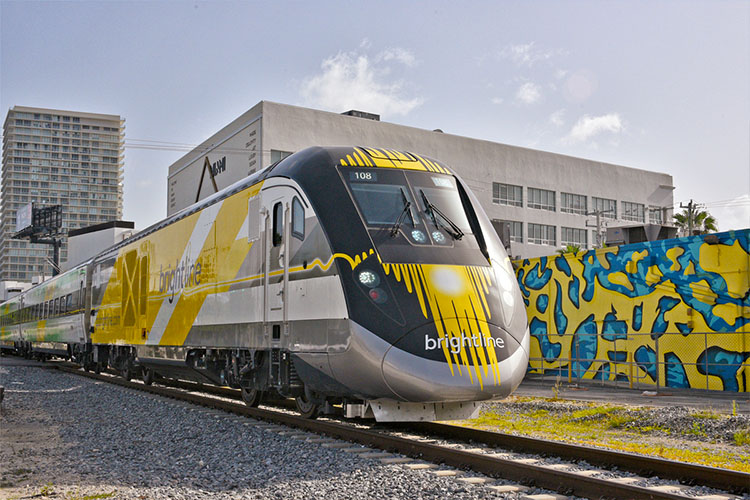
“One of our internal mantras,” he says, “is that we think we can help people arrive happy.” He tells an anecdote about a customer whose massage therapist noticed that she’d given up driving due to the absence of knots in her back. “But this is the biggest driver of customer adoption,” he says, holding up his iPhone. “People can’t get enough of their screens.”
The next day I take a Lyft to the Fort Lauderdale Brightline station, a very modern and sleek building with a concession selling Illy coffee and decent-looking pastries. Top-40 music plays loudly over the speakers and the air is redolent of a piney scent that Brightline had custom made for their stations. The train arrives and everyone hops aboard.
The cars are spacious, full of grey leather seats with extendable footrests. Seats are assigned, and everyone seems to shift to work mode as soon as we’re in motion, a chorus of unfolding laptops and tip-tapped smartphones. The gentleman across from me is an accountant who takes the train every day. He says he prefers it because he can get a jump on work, which he pores over as we cruise to Miami at 67 mph without stopping.
Brightline owes its passenger line to Henry Flagler, John D. Rockefeller’s partner in Standard Oil. A lover of trains, Flagler had to move to Florida for his wife’s health. Once there, he spent his own money to build the Florida East Coast railroad. It traveled the Florida coast, extending from the national line outside of the state to his hotel in St. Augustine all the way down to Key West. Though some of the tracks were lost in a hurricane in 1935, passenger service lasted until the 1950s, when it was sold to the heirs of the duPont family, who began running it as a freight rail.
But the easement that stipulated passenger right-of-way carried with the deed. Wesley Edens, of Fortress Investment Group, caught on to this, and bought it in 2006. He decided to reinstitute a passenger service called All Aboard Florida, which was renamed Brightline in 2006. Construction began in 2014 to remodel the existing line and ensure that crossroads were up to code, and service launched in 2018.
“The FEC was a tremendously unique line,” says Porritt. “In many ways, this project was built already advanced. [Fortress] had the foresight to recognize how tremendous an asset like this was. It’s almost like this project — or this concept of the rebirth of passenger rail in America — almost couldn’t have happened without the private ownership of the FEC.”
Brightline made the news last year with a Virgin Trains partnership, and Richard Branson flew over for the announcement. People in the train world wondered if Brightline was in financial trouble. But ridership is flourishing: Brightline moved from 16 round-trip journeys per day to 17 in 2019, and plans to increase service on game days and during popular events like Art Basel.
It appears the Virgin deal is merely a licensing agreement, with Virgin owning less than a three-percent stake in the company. A full rebrand incorporating the Virgin name will take place in 2020, and when Brightline opens service from Miami to Orlando and L.A. to Las Vegas, the European and Asian tourists who travel en masse to those destinations will see a familiar name on brochures and billboards. They can also expect a level of concierge service on par with a five-star hotel: “We check your bags straight to your room,” says Porritt. “You’ll start your Vegas or Orlando experience right when you get on the train.”
The Next Generation Awaits
The Vegas train, unlike its counterparts in Florida, will be a true “3P” project — the kind of public-private partnership that Gomez and CHSR dream of. Porritt acknowledges this, saying that Brightline “shares the same vision as most of the public transportation networks that [Brightline] either connects to or sees across the country. It’s about increasing connectivity and mobility and providing people options to get out of their car.”
Though government support is strong in Florida and California, federal support for high-speed rail construction has fallen off completely since 2016. Much of California’s program received initial funding under the Obama administration, which handed the state two grants totaling around $3.5 billion despite pushback from former attorney general and then-Alabama senator Jeff Sessions, among others. Much of those funds had gone underutilized until this week, when CHSR announced a plan to move forward with the biggest contract in its history, a 30-year engagement that would complete “more than half the proposed Los Angeles-to-San Francisco system,” according to the LA Times. That plan flies in the face of rollbacks on the Obama grants imposed by the U.S. Department of Transportation earlier this year, suggesting that the state is making a huge gamble that a new administration will be in place by the time those contracts get underway.
Historically, rail projects have gotten the federal government’s blessing with little resistance. While the trains themselves were privately owned, they were publicly financed through land grants, direct loans and subsidies — they had to be, since building a railroad is so expensive. At times, the capital needed to fund the projects was coaxed with the help of lobbyists and lawyers, including a young Abraham Lincoln. At other times, the government itself stepped in with legislation to entice entrepreneurs to take on projects, as was the case with the transcontinental railroad, which was pushed through by Lincoln during the Civil War (his conservative rivals couldn’t object, since they were Confederates). Government bonds during this time amounted to $16,000 per mile over flat lands and $48,000 per mile in mountains — $406,000 and $1.2 million today, respectively.
While the federal government was responsible for early financing and land orchestration, the private sector accounted for the technology. Whether it was George Pullman’s luxurious sleeper cars or improvements to braking systems that prevented crashes or the evolution from steam to diesel to full electric power, the rail industry has long been a model for technical innovation. And that’s an area where Amtrak — thanks to a lack of adequate funding — simply hasn’t been able to keep up.
When I compare my Brightline experience in Florida to the ride I took up the California coast, it almost feels like I was riding trains from two different eras. The conductors on Brightline use a device to scan tickets and peddle craft beer and artisanal potato chips. Amtrak conductors, meanwhile, still do everything with a pad and pen, and the concession car is about as inspired as an office vending machine. There’s also the question of Amtrak’s prehistoric booking site, which everyone I interviewed agreed is about as clear as mud. (That there’s an equally lo-fi website called Amsnag that culls Amtrak’s schedule for a simplified experience is telling.) Brightline’s ticketing app is self-contained and works seamlessly with the touch-screen kiosks at the station. From the booking process to the cleanliness of the stations to the on-board service, providing a superior customer experience is where the private sector shines.
However impressive the news is regarding Brightline, the big buzz in train travel these days is coming from another source: Elon Musk’s Hyperloop concept. According to press releases, various Hyperloop companies are already working with transportation authorities in North Carolina, Texas, Missouri-Kansas and Nevada. One of them — a Virgin-backed venture called Hyperloop One — goes so far as to claim that a Las Vegas-to-L.A. leg will be functional in 10 years.
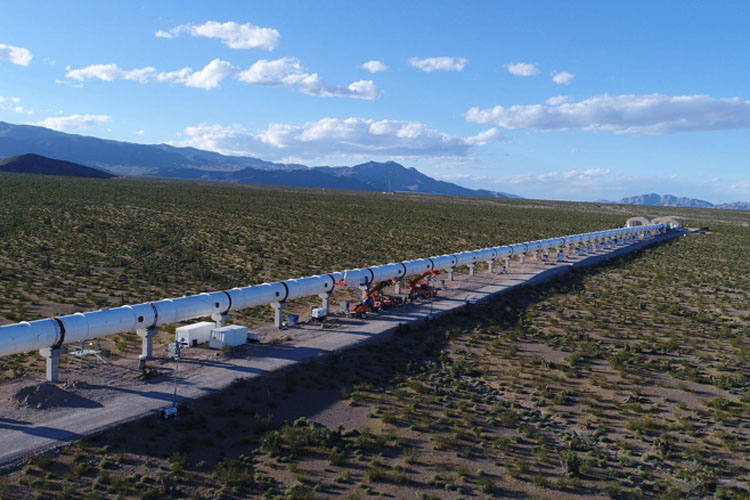
For that to happen, they first need to move beyond a testing phase to ensure that this entirely new and theoretical form of technology is actually safe. While doing that, they’ll also need to accumulate land and permits, a process that took nearly a decade for CHSR, itself a government entity.
The logistical reality clearly favors traditional rail projects, which have a long and storied track record and are easier to erect than a completely new technology. America already has more rail lines than any country in the world, and a very profitable freight business that runs on them. That passenger service isn’t as robust as it could be isn’t because we’re lacking adequate technology. It’s because we’ve poured all available resources into cars and planes for the better part of a century. In that same timeframe, Japan and Europe built incredibly efficient and popular passenger trains thanks in no small part to an influx of American capital after the second World War.
There are signs that public support for better rail infrastructure is (finally) shifting in the U.S. CHSR still polls at a 57-percent approval rating, while Brightline has been well received by passengers in Florida. The factor driving this shift is no secret: climate change. The transit industry accounts for 15 percent of manmade emissions globally, and 70 percent of Americans between the ages of 18 and 34 identify as worried “a great deal” about climate change, a number that transcends party lines.
The truth of the matter is that a national referendum on rail travel — and the deluge of both public and private funding it so desperately needs — is likely to be a function of a social phenomenon known as “generational replacement.” Consider that in the 1980s, the majority of Americans thought homosexuality should be deemed illegal. Thirty years later, it’s accepted by the majority, and gay marriage is a federally protected right. The dissenters didn’t change their minds, as the Economist points out. They died. It stands to reason that a similar shift will happen with action regarding climate change.
Back on the Starlight, as he mulled over his jumble of cryptic longhand equations, Todd Parsons had explained to me that his lecture series wasn’t only about the spread of diseases, but also the spread of ideas. He told me that at a talk in Houston, he and a colleague had discussed how misinformation tends to proliferate in the digital age. They determined that the mechanics of the process are in fact quite similar to the ways in which diseases “go viral.”
And the same, he said, could be true of a good idea.
This article was featured in the InsideHook SF newsletter. Sign up now for more from the Bay Area.

